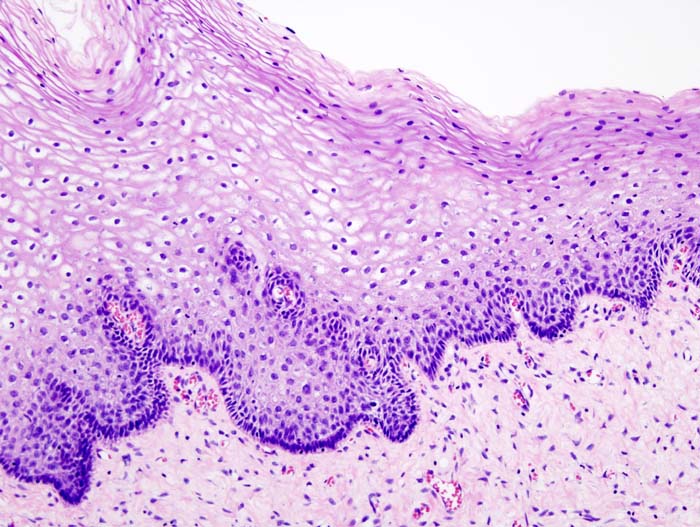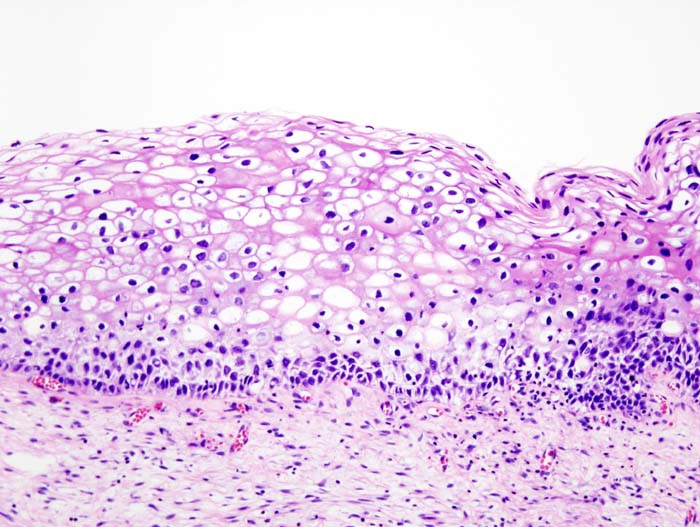Cervical dysplasia classification: Difference between revisions
Jump to navigation
Jump to search
No edit summary |
No edit summary |
||
| Line 1: | Line 1: | ||
__NOTOC__ | __NOTOC__ | ||
{{Cervical dysplasia}} | {{Cervical dysplasia}} | ||
{{CMG}} | |||
Please help WikiDoc by adding more content here. It's easy! Click [[Help:How_to_Edit_a_Page|here]] to learn about editing. | |||
==Classification== | |||
Depending on several factors such as the type of HPV and the location of the infection, CIN can start in any of the three stage, and can either progress, or regress.<ref name=Robbins/> | |||
CIN is classified in grades: | |||
{| class="wikitable" | |||
|- | |||
! Histology Grade | |||
! Corresponding Cytology | |||
! Description | |||
! Image | |||
|- | |||
| – | |||
| – | |||
| Normal cervical epithelium | |||
| [[Image:Cervical intraepithelial neoplasia (1) normal squamous epithelium.jpg|center|100px]] | |||
|- | |||
| '''CIN 1''' (Grade I) | |||
| [[low grade squamous intraepithelial lesion|LSIL]]<ref name="Park">{{cite journal |author=Park J, Sun D, Genest D, Trivijitsilp P, Suh I, Crum C |title=Coexistence of low and high grade squamous intraepithelial lesions of the cervix: morphologic progression or multiple papillomaviruses? |journal=Gynecol Oncol |volume=70 |issue=3 |pages=386–91 |year=1998|pmid=9790792 |doi=10.1006/gyno.1998.5100}}</ref> | |||
| The least risky type, represents only mild [[dysplasia]], or abnormal cell growth.<ref name="Agorastos"/> It is confined to the basal 1/3 of the epithelium. This corresponds to infection with HPV, and typically will be cleared by immune response in a year or so, though can take several years to clear. | |||
| [[Image:Cervical intraepithelial neoplasia (2) koilocytosis.jpg|center|100px]] | |||
|- | |||
| '''CIN 2/3''' | |||
| [[high grade squamous intraepithelial lesion|HSIL]] | |||
| Formerly subdivided into CIN2 and CIN3. | |||
|- | |||
| '''CIN 2''' (Grade II) | |||
| | |||
| Moderate dysplasia confined to the basal 2/3 of the epithelium | |||
| [[Image:Cervical intraepithelial neoplasia (3) CIN2.jpg|center|100px]] | |||
|- | |||
| '''CIN 3''' (Grade III) | |||
| | |||
| Severe dysplasia that spans more than 2/3 of the epithelium, and may involve the full thickness. This lesion may sometimes also be referred to as cervical [[carcinoma in situ]]. | |||
| [[Image:Cervical intraepithelial neoplasia (4) CIN3.jpg|center|100px]] | |||
|} | |||
==References== | ==References== | ||
{{reflist|2}} | {{reflist|2}} | ||
| Line 7: | Line 45: | ||
{{WS}} | {{WS}} | ||
[[Category:Needs | [[Category:Needs overview]] | ||
[[Category:Disease]] | [[Category:Disease]] | ||
[[Category:Gynecology]] | [[Category:Gynecology]] | ||
[[Category:Oncology]] | [[Category:Oncology]] | ||
[[Category:Types of cancer]] | [[Category:Types of cancer]] | ||
[[Category:Needs content]] | |||
Revision as of 13:46, 12 March 2013
|
Cervical dysplasia Microchapters |
|
Diagnosis |
|---|
|
Treatment |
|
Case Studies |
|
Cervical dysplasia classification On the Web |
|
American Roentgen Ray Society Images of Cervical dysplasia classification |
|
Risk calculators and risk factors for Cervical dysplasia classification |
Editor-In-Chief: C. Michael Gibson, M.S., M.D. [1]
Please help WikiDoc by adding more content here. It's easy! Click here to learn about editing.
Classification
Depending on several factors such as the type of HPV and the location of the infection, CIN can start in any of the three stage, and can either progress, or regress.[1]
CIN is classified in grades:
| Histology Grade | Corresponding Cytology | Description | Image |
|---|---|---|---|
| – | – | Normal cervical epithelium |  |
| CIN 1 (Grade I) | LSIL[2] | The least risky type, represents only mild dysplasia, or abnormal cell growth.[3] It is confined to the basal 1/3 of the epithelium. This corresponds to infection with HPV, and typically will be cleared by immune response in a year or so, though can take several years to clear. |  |
| CIN 2/3 | HSIL | Formerly subdivided into CIN2 and CIN3. | |
| CIN 2 (Grade II) | Moderate dysplasia confined to the basal 2/3 of the epithelium | ||
| CIN 3 (Grade III) | Severe dysplasia that spans more than 2/3 of the epithelium, and may involve the full thickness. This lesion may sometimes also be referred to as cervical carcinoma in situ. |